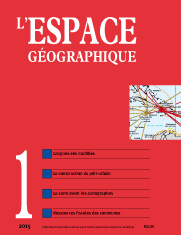

Diffusion and spatial dynamics of Creole languages in the Caribbean (3 fig.)
The aim of this article is to highlight the common geo-linguistic structure of Caribbean creole languages, to represent the diffusion of these various creoles throughout the region, and to propose a modelization of Caribbean creole spaces and spatial dynamics. These dynamics of creation and destruction, expansion (creolization) and withdrawal (de-creolization), at the local and regional scale alike, generated a creolophone Caribbean, which encompasses over 14 million speakers in various territories characterized by distinct features.
keyword: CARIBBEAN, CREOLE LANGUAGE, DECREOLIZATION, DIFFUSION, MODELIZATION
The birth of the outlying urban area as statistical category in France (1 encadré; 4 fig.; 1 tabl.)
Outlying urban areas as a statistical category did not appear in France until relatively late. It belongs to an American tradition that began in the 1930s-1960s with a handful of sociologists from the universities of Chicago and Wisconsin, and later with “New geography”. This is when it acquired its fundamental characteristics: an economic approach to the city, the hierarchy between central and peripheral entities, the novel criteria of commuting. This definition was then adopted in Europe, not without a certain amount of resistance in France. We offer several possible interpretations. Finally, we demonstrate that it is not so much the circulation of concepts that is in question but rather that of the models used to implement the definitions. The argument of the homogeneity of criteria, expounded for international comparison, is placed in opposition to the specificity of national contexts: administrative meshes, the urbanization process, and the very meaning of what makes a “city”.
keyword: DEFINITION, EUROPE, FUNCTIONAL URBAN AREA, UNITED STATES OF AMERICA
The spead of maps and the affirmation of geographical knowledge in France. The paradoxes of implementing the use of geographical maps during the 18th century (2 fig.; 2 photos; 1 tabl.)
Before Geography became a discipline in France (around 1890), one of the elements that needed to be taken into account in order to determine geographical knowledge was the map. The titles of “Royal Geographer” in the eighteenth century were awarded to authors of maps and plans. This relationship between maps and geography is problematic for at least two reasons. First, there are other forms of geographic discourse, and second, the map, whose use spread during the Age of Enlightenment, is also used by other fields of knowledge. This is a root cause for the fragility of geographical knowledge, which partially explains its late institutionalization as a discipline.
keyword: DISCIPLINE, GEOGRAPHER, GEOGRAPHY, KNOWLEDGE, MAP
Residential function and local fiscal resources on the French Mediterranean coastline (3 fig.)
This paper explores the issue of local taxation in a context of an accelerated urbanization of coastlines. It demonstrates that the financial resources of local authorities are increasingly dependent on the residential function. It presents a diachronic perspective of the drivers of this process and identifies a rate-effect and a base-effect to characterize the trajectories of coastal territories. The ultimate goal of the article is to analyze local taxation as a key determinant of current land use models and of their sustainability.
keyword: COASTAL URBANIZATION, FISCAL RESOURCE, LITTORALIZATION, LOCAL TAXATION, RESIDENTIAL ECONOMY
New cantons in France: Names games (2 fig.)
The 2 054 cantons that resulted from the 2014 reform, and who elected their first representatives in 2015, have profoundly modified France’s administrative map. As before, most of these cantons were named after their central commune; however, the chance to give them other names was taken by 31 out of 98 departments. There are now 223 new names based on the names of rivers, contours, of local or historical references, and sometimes with a desire for fame. These new names are highly concentrated in the France’s south-west, which leads to several research hypotheses.
keyword: AQUITAINE, CANTON, ELECTION, FRANCE, MIDI-PYRÉNÉES, TOPONYMY
Anita W. LAU-BIGNON. Tonle Sap, historical basin of civilisations (3 fig.; 9 photos)
Book reviews
In this issue of l’Espace géographique, you will find critical reviews of the following books
FELSCH P. (2013). Comment August Petermann inventa le Pôle Nord. Traduit de l’allemand par Olivier Mannoni. Préface de Sylvain Venayre. Paris: Éditions de la Maison des sciences de l’homme, 194 p. (François Walter, université de Genève) ISBN: 978-2-7351-1640-9
BERTONCIN M., PASE A. (2012). Autour du lac Tchad. Enjeux et conflits pour le contrôle de l’eau. Paris: L’Harmattan, coll. «Études africaines », 354 p. (David Blanchon, université Paris Ouest La Défense) ISBN: 978-2-296-99057-9
PASE A. (2011). Linee sulla terra: confini politici e limiti fondiari in Africa subsahariana. Rome: Carocci, 326 p. (David Blanchon, université Paris Ouest La Défense) ISBN: 978-88-430-6233-1
FERRIER J.-P. (2013). La Beauté géographique ou la métamorphose des lieux. Paris: Economica-Anthropos, 132 p. (Régis Darques, CNRS Montpellier) ISBN: 978-2-7178-6558-5
CREAGH R. (2013). Élisée Reclus et les États-Unis, suivi de son Fragment d’un voyage à la Nouvelle-Orléans. Paris: Noir & Rouge, 72 p. (Philippe Pelletier, université Lyon 2) ISBN: 978-2-9543610-0-0
BRUN C. (2014). Élisée Reclus. Les Grands Textes. Paris: Flammarion, coll. «Champs classiques», 514 p. (Philippe Pelletier, université Lyon 2) ISBN: 978-2-08-128990-1
FERRETTI F. (2014). Élisée Reclus, pour une géographie nouvelle. Paris: CTHS, 450 p. (Philippe Pelletier, université Lyon 2) ISBN: 978-2-7355-0827-3
LEFORT I., PELLETIER P. (dir.)(2013). Élisée Reclus et nos géographies. Textes et prétextes. Paris: Noir et Rouge, 458 p. (Philippe Pelletier, université Lyon 2) ISBN: 978-2-9543610-2-4
CUNY C. (2014). Changement urbain et démocratie participative à Berlin, ethnographie du grand ensemble de Marzahn. Paris: Éditions de la Maison des sciences de l’homme, coll. «Ciera-Dialogiques», 338 p. (Claude Bataillon, CNRS Paris) ISBN: 978-2-7351-1641-6
FRILEUX P. (2013). Le Bocage pavillonnaire. Une ethnologie de la haie. Paris: Créphis Éditions, 288 p. (Muriel Rosemberg, UMR Géographie-cités, équipe EHGO Paris) ISBN: 978-2-35428-075-8
L’espace géographique 4/14![]()
![]() L’espace géographique 2/15
L’espace géographique 2/15
For subscribe or buy this issue: BELIN
![]() L’Espace géographique: contents
L’Espace géographique: contents
Last modified: june 16, 2015